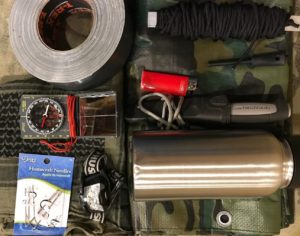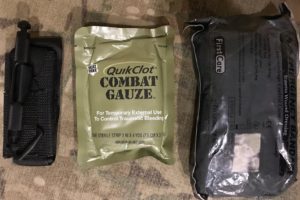October 21, 2017
There are four levels of preparedness: personal preparedness, vehicle preparedness, home preparedness, and retreat or bug out preparedness. The focus of this series is on your personal preparedness. When we talk about personal preparedness, there are four basic aspects that fall into this category: spiritual preparation & mindset (see PART 1), physical body (see PART 2), personal skills (see PART 3), and gear. The focus of this article is about the gear you should carry with you on a daily basis.
Every day carry (EDC) gear is an area that is very often covered in detail. There are a variety of opinions on all of the items that you should carry. This is a general overview that covers many of the basic items you should carry with you. The EDC kit should be tailored to the individual based on your own situation and circumstances. The EDC also changes for some of us as the seasons change. Having distinct changes in the weather from summer to winter will cause some adjustments to be made. Some things will be added or changed out. The EDC will change based on your knowledge, skill level, health, and medical situation dictates. The goal of the EDC is to provide you with a sufficient amount of tools & gear to get you to your vehicle, home, or to more equipment. In pursuit of your goal, you have both the ability to defend yourself and endure the elements temporarily.
The first piece of "kit" that you should have is a means of self defense. You can have all the greatest survival tools in the world, but if a thug beats you down and takes it, what good is it? As an American citizen, unlike many in the rest of the world, you have the right to carry a firearm for self defense in most places. You should have your concealed carry gear wherever you are able to carry. Your concealed carry gear includes not only your firearm, but also the holster you choose, extra magazines, a flashlight, a less lethal option like pepper spray, and a knife. It should go without saying that all of this gear needs to be quality made. How much is your life worth?
When it comes to anything related to firearms, everyone has an opinion. I would suggest that you choose a quality mid-sized to full-sized handgun in a common caliber as your defensive firearm. When it comes to gun fighting, it is much easier to shoot and manipulate a firearm that is mid to full sized. A smaller firearm may be a little easier to conceal (which is debatable), but it is not easier to shoot and hit your target at distance. Concealment of a larger handgun is not that difficult to accomplish with a rig made of Kydex. Kydex holsters & mag pouches hold your firearm & mags securely, close to your body and minimize "printing".
The handheld flashlight you choose is also important. Even if you decide to carry a handgun with a weapon mounted light, you still need a handheld flashlight. Many times a flashlight is needed, but a firearm is not. A flashlight can be used for searching, navigation, communication, and self-defense. With advances in flashlight technology, there are many quality lights that are not too expensive. Get an LED light that is also shock resistant. You should not have to worry about the light failing if you accidentally drop it or use it as an impact weapon. This was not the case in the old days. I can remember dropping my flashlight on several occasions when I needed it and having the filament break. I was smart enough to realize the importance of redundancy back then and always carried a back up flashlight or two. Only put quality batteries in your flashlight. Sure the cheap Lithium batteries from China are a little less expensive, but many people have experienced the cheap batteries short circuit causing damage / fire to their gear. It's not worth the little bit of money you save.
Keeping a little bit cash on you in small denominations is also valuable. It could be used to buy a variety of things including food, water, and transportation, but there are many other uses as well. If you think someone is going to try to rob you or worse, the small amount of cash can be used as a distraction to "buy you time" to escape, evade, or go into defense mode. In a pinch the cash could be used as a fire starter. (It's almost worthless anyway.)

The next items, taken from Dave Canterbury's Pathfinder School, are the 10 C's of Survival. As you'll see while we go through the list, several of these items have been included previously. There is some overlap / duplication (two is one, one is none). Think of these as categories that can be used in an emergency situation with each item having multiple different uses. I won't list all of the uses here, but a good mental exercise is going through the list and thinking of all the ways each item could be used. These are not just "wilderness survival" items either. Many of the items can be used in a self defense situation. Consider that as you are thinking of uses for each item.
1. Cutting tool, i.e. a knife - Since the knife was already included in the self defense gear consider this to be a fixed blade knife like a Morakniv and/or a multi-tool.
2. Combustion Device - a lighter and/or a fire steel.
3. Container - This should be a stainless steel water bottle which can be used to boil water in a fire.
4. Cordage - Consider 550 cord aka paracord here because of its multiple uses.
5. Covering - The covering should be waterproof, like a tarp.
6. Candling device i.e. flashlight - You already should be carrying a light with the CCW gear. Consider a small headlamp here if you have the room in your kit.
7. Compass - Find a compass with a sighting mirror and magnifying glass because of the multiple uses.
8. Cloth Sail Needle - Consider getting a needle multi-pack that also has curved needles in it. The needles can be used for sewing up gear, but also for stitches and even a fishing hook.
9. Cotton Bandanna - Consider a Shemagh here because of its multiple uses.
10. Cargo Tape aka Duct Tape - There are tons of uses. Enough said.
You should also have a personal medical kit with you to treat yourself as needed. The main items you should have is a tactical tourniquet (aluminum tourniquet handle is best), an Israeli bandage, Quick clot gauze, and a chest seal (training required on this one). This is a kit you have to treat yourself in a worst case scenario situation. You should make personal additions to this kit as you see fit.


One thought on “ARE YOU PREPARED FOR SITUATIONS THAT MAY ARISE? PERSONAL PREPAREDNESS PART 4”
Comments are closed.